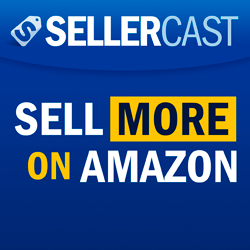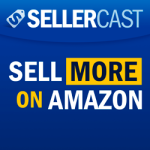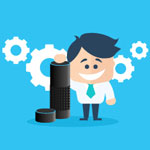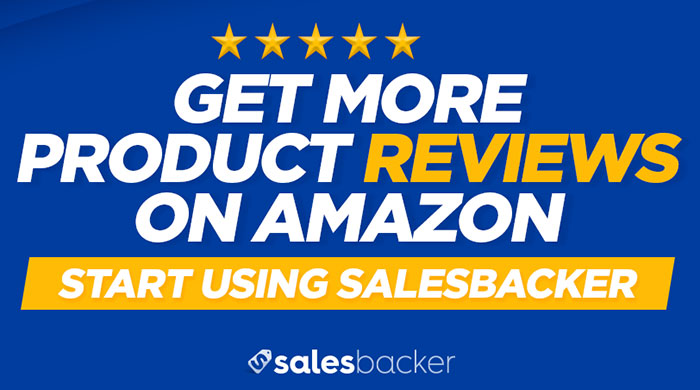 Direct podcast MP3 download link
Direct podcast MP3 download link
Like the show? Get new episodes on iTunes or Stitcher
Tony joins us on the show today, and he has an interesting story to share. He tried not once, but twice to launch a private label product, and both times he struggled. On his third attempt, he partnered up and bought an ecommerce business that was already selling on Amazon. In this episode, Tony shares how he found this business, what he did to be on track to double the sales, and more.
Want to ask a question?
Get involved and ask a question about selling on Amazon and Chris may answer your question live on a future episode of Sellercast. Also, if you think you'd be a good guest for the Sellercast podcast feel free to tell us more about you and your company here.
Need more product reviews?
If you'd like to get more reviews for your products on Amazon check out Salesbacker.
Podcast Transcript
Intro: Hello, everyone. Chris Guthrie here, host of Sellercast. And in today’s episode, I speak with Tony who’s had a very interesting path to eventual success.
He started an ecommerce business on Amazon, had some initial success, but then also had a few struggles along the way which we’ll talk about in this episode. And so instead, he partnered with a few other people and they purchased a business. And already, in the four months they’ve owned that business, they’ve nearly doubled the sales.
So, he talks about what he did to grow that business, how he found it. And it’s a really interesting. I know you’re going to enjoy this episode.
The other thing I want to draw your attention to before we start this recording is you can go to sellercast.com/workshop if you’d like to learn how to get more product reviews for the products you’re selling on Amazon. I’ll be talking all about that.
So, if you want to check that out, sellercast.com/workshop. Otherwise, let’s start the show.
=====
Chris: Welcome to the show, Tony.
Tony: Hey, Chris. Thanks a lot for having me.
Chris: Yeah, I’m really excited that you’re here because this is a very different story than we’ve had with past guests. I know that’s something I commonly say. But this time, it’s definitely true. We’ve not had someone on the show who’s had the background that you have in the ecommerce space.
So, I know you’re going to talk just a little bit about how you purchased a business as opposed to starting off from scratch. So let’s actually just dive into your background. Did you first start in ecommerce beforehand, and then you decided to buy one? What made you decide to buy one in the first place?
Tony: I did actually. I actually tried to start my own product twice over actually. And both of them failed.
They weren’t massive failures, but I ended up breaking even on both of them. I just decided that the opportunity wasn’t right. But I learned a great deal from both of them. And I think that what I learned absolutely helped in the success of the business we ended up purchasing.
Chris: Yeah, that’s awesome.
So, you said “we.” Did you bring on a partner to help purchase this? How did that conversation go?
Tony: We had a pretty interesting dynamic. I worked for a large Fortune 100 company. I did my master’s in business. They paid for it. But I knew that I wanted to become a business owner.
I had the opportunity to join a small private equity firm. It’s basically a family-owned business. My brother had already been working there, and he had been able to purchase a business with the owner. So, I was going to be the third partner.
We ended up bringing on another partner. And we had an excess of human capital. And the plan all along was to buy another business.
So, the four of us currently manage three companies including the one that we purchased in January which is the ecommerce company that I’m going to explain to you guys today.
So basically, we had the chance to have someone help us to finance a deal. It allowed us to basically go and purchase this company. And that’s where we’re at today.
Chris: That’s great! I like that. I’ve talked to some people that have done similar things where either they had a business that they started before or they’ve worked for private equity. And then, either they do things where they get capital to help the business or they leverage their expertise, and that helps them earn equity into the business. And then, someone else still puts up most of the capital.
It sounds like you didn’t have to put in a ton of money to this business—or maybe you did?
Tony: Well, we didn’t actually. The dollar portion wasn’t that large. It wasn’t a burden. It was more of a symbolic investment on our part. But the owner is a silent partner. We do all of the grunt work.
It’s actually not that much. I’ll go into that a little bit later. But we were basically working for sweat equity. And it’s going to end up being an extremely good deal for us. And hopefully, it’s not the last. We’re definitely planning on it not being the last.
Chris: Yeah, okay. There are a lot of things that you touched on that I want to come back to. But let’s actually talk a bit about—well, actually, I want to go back just briefly to the first two proxies. So are you able to share roughly what those products were and why you think they failed?
Tony: Yeah, I’ll tell you what they are. I thought I had a really good little niche. I was looking at surfboard leashes, and specifically, stand-up paddle boarding leashes. It attaches to your ankle and attaches to the surfboard. And if you fall off, it basically prevents the board from flying to other people and away from yourself.
I was looking at this product for a while. There was basically one big player, and he was clearly a private label type guy. He’s probably selling—my calculation is about between 20 and 30 units a day. I figured, “Hey, if I can come in and do five or ten units a day and be like the second player, I can have a $50,000 or $100,000 business, and he wouldn't even notice.”
I basically found a pretty quality product on Alibaba. I got about five different samples in. I got the product in. I liked it, good price. I ended up branding it with my brand. And two initial success actually. I was selling five to eight units a day. I was making a good profit.
I was selling it for cheaper than the leader, the leading guy in the category was. And things were good. And basically, after about a month, he ended up dropping his price to lower than mine.
So, I can tell that he was just trying to bully me out of the market. I was kind of hanging in there. And then, probably, in the next two weeks, five other private label guys came in with the same, exact product.
It was astonishing! And this was about exactly a year ago today that that product went through.
Chris: Okay. So that’s that one. What about the other one? How long was after the next one you tried, a few months after?
Tony: Yes. This was about two or three months after that. This was in workout gloves, and specifically for crossfit. So, I found essentially the same product was being sold by a top seller. I basically brought it in unbranded.
If you’re familiar with Will Tjernlund, he advocates finding 10 products. Basically, buy a couple of units and see what sticks. And this was one of my attempts.
It worked out really well at first. I went through the first 20 units pretty quickly, and I was ready to put in a bigger order. And the top seller actually sent me a cease and desist. It just didn’t really seem like the risk was worth the possible litigation.
I didn’t think he had too much to stand on because I did a little bit of a research in the patent that he did have. I didn’t think it applied to this. But I didn’t see it as a good omen. I ended up not pursuing that.
Chris: Yeah, that’s going to always make you shrink a little bit I guess. Okay.
Tony: But two very good lessons found—one being if you’re going to private label something, either improve it from others in the same category or just completely work in an area that you have a competitive advantage that you can clearly see—oftentimes, that’s a lot easier said than done—and second, don’t buy knock-offs.
Chris: Yeah! Well, good. I like I when people can share specific examples. I know not in every case, people can do that, but I appreciate that.
So now, let’s talk about this deal then. What did you pay for this business then? Maybe you can talk about some of the structure of it.
Tony: Sure! Do you want to talk about sourcing the deal or do you want to go a little…?
Chris: Yeah, actually, yeah. Yeah, let’s find out how you actually found it.
Tony: Sure, sure. Honestly, we went onto a website called Biz Buy Sell.
Chris: There are a lot of business brokers that put all types of businesses on the website. So, we primarily look at Internet businesses. And like I said before, a lot of junk on there.
We probably filtered through 500 listings over a few months. We probably inquired on 40. We got NDAs, non-disclosure agreements, on 20 of them. We were actually pretty serious about buying five of them. We actually put in letter of intents on—I think it was three businesses. For whatever reason, they didn’t work.
We just kept pounding the pavement and talking to business brokers. And we ended up finding—we stumbled upon this business. We didn’t really think much of it at first. But the more we looked into it, it seemed pretty interesting. It ended up being the company that we bought.
So, I can go in a little bit about the deal structure.
Chris: Yeah.
Tony: So, the company was doing about $385,000 in revenue.
Chris: A year?
Tony: Yeah. So $200,000 of that was on Amazon. The other $180,000 or so was through its own website.
So there’s two components to the business. It was extremely profitable. The net profit margin was about 40%. So we were looking at about $150,000 in EBITA. That’s basically profit before tax. And we ended up paying about—I think it was right about $400,000 for the business.
Chris: So, a little over 2x or a little over 3x I guess, yeah.
Tony: Yeah, exactly. And I’m not sure if the audience is too familiar with buying businesses. But if you can buy a business at 2x EBITA, you’re not going to really find those types of deals in the MNA world.
So, when you’re playing in smaller deals like this, you can get away with really, really low and reasonable multiples.
Chris: Yeah, yeah. That’s great. So, you basically just looked at a lot of different deals. You had some letter of intents (LOIs) out on some of the businesses. This one ended up working out.
So, how long ago did you buy this business then?
Tony: We closed on January 20th of this year.
Chris: Okay. And so, when you purchased the business, did you pay it all upfront or earn-out or seller financing for any part of the deal or anything like that?
Tony: That’s a great question.
Chris: We put up about half of the business, about $200,000 was sent upfront. We structured about $60,000 a year as a seller note. So basically, we have to then pay the guy who sold it to us $60,000 for the next three years. So that’s about $320,000 of the $400,000. And the rest of the dollars, about $80,000, is paid in a consulting agreement.
The reason we structured it like that—I don’t want to get too technical or financial—it was most beneficial to the seller to do that for tax purposes. So, it was very seller-friendly. So he also has an incentive to help us if anything should go wrong—which something did go extremely wrong right off the bat, which is pretty interesting.
Chris: Okay! So yeah, I like that. I’m assuming you structured it that way, so you don’t have to get hit really a lot on taxes in the beginning. And then he also spread his payments out for a little while, so he could keep making cash along the way too, which is nice for him. Is that the gist of it for him, on his side?
Tony: Yes.
Chris: Cool! So what happened then? Can you talk a little bit about what category…?
Tony: Yeah. So, we’re in office products—and more specifically, we’re in specialty paper products. So that was one of the reasons why we were initially turned off because we were figuring, “Who uses paper anymore? People are going digital.” The more we looked into it, it was actually growing. Sales were growing the past two years from what we can see, loyal customer base and a great brand. So, we looked a little bit closer at it, and we started to really see the potential.
Chris: That’s great! Okay. So then, you purchased the site—not the site, that’s a common thing I say. So you purchased the business in January of this year. And the very first thing that happened, it sounds like, something went wrong. So what happened, something on the Amazon side or something else?
Tony: So, it ended up affecting all aspects of the business. The guy we purchased the company from was based out of Connecticut. He kept all of the inventory at a third party warehouse.
So, we had an agreement with that third-party warehouse that said they would agree to basically keep our rates exactly the same, and there really wouldn't be any change to us or the warehouse.
Well, two weeks into the deal after we exchanged hands, they decided to triple our costs which meant that every time that we sent a package—they did all of the fulfillment as well. Every time they sent a package, it would’ve cost us three times more to do it, which obviously, materially affects the business and what we purchased it at.
So, this is obviously not the greatest news. But fortunately, we have a warehouse and a manufacturing facility at our disposal where we run the other two businesses out of. We got everything shipped back to our location here in Cleveland. We brought racks, we racked it all up. But we basically couldn't ship anything for three weeks. And that includes stuff going to Amazon as well. So, it was a pretty big hit to the business from the get-go.
Chris: So were you able to recover with your ranks and your sales after you were able to successfully move to a new fulfillment location?
Tony: We did, we did. It was a lot of work. But in the end, it’s actually going to be more profitable for us because we don’t have to pay that third-party seller to do the shipments and send things into Amazon.
So, it is a little bit more work for us. I’ll go into a little bit more later I think about how much time a week that we actually spend on this business.
Chris: Yeah, go ahead. How much time are you spending now? Do you have to have people help with the fulfillment? You have to add staff rather to help with the increased volume from the third business now being out of that warehouse?
Tony: We didn’t actually have to hire anybody. The only physical work on a day-to-day basis is shipping out orders that are placed on our organic website. And that can be between five or ten orders a day. It takes us probably 20-30 minutes a day.
So, just operational, it probably takes us 2 ½ hours a week to operate this business.
Chris: Oh, that’s great. So then, how is this performing after that? After you got everything sorted out, were you able to then leverage a lot of what you learned from the first couple of mistakes just from your general knowledge of the Amazon platform to then try to grow that side of the business? Where did you focus on first?
Tony: So, because I had had previous experience with trying to do private label Amazon products, I was in charge of the Amazon side of the business, which, like I said before, was running at about $200,000 for fiscal 2015.
Now, I knew that the previous owner was doing no ad campaigns. He wasn’t doing automated emails. He’s basically doing the bare minimum.
So, I had forecasted for the business, maybe we can do 10% growth, 10% or 20% growth, which would put us $220,000 or $240,000 for 2016. And we would’ve been happy with that. We’re currently on pace to do $350,000 which is 75-ish% growth.
Chris: Yeah, that’s great.
Tony: So that was one of the big reasons we were really excited about the business because we felt that he was really not putting any effort into the Amazon side of the business which turned out to be correct.
Chris: And how old was the company? I don’t know if you’ve mentioned that. I’m just curious to see how long the seller had it before.
Tony: Yeah, it’s really interesting. The brand actually goes back to the ‘50s. It’s really interesting. The gentleman who we purchased it from bought it from the original owners. The original owners actually weren’t making much money because of the rising cost of US manufacturing.
The gentleman who we bought it from kind of specialized in sourcing products overseas, so he took the same exact product, sourced it overseas for—I’m guessing—at least half the cost, and started selling it on Amazon and on his website. I guarantee that he, at least, doubled their sales by doing just that and doing the bare minimum.
Chris: That’s awesome. And so he ran it for—how many years?
Tony: I think he ran it for five years.
Chris: Okay. Okay, cool.
So then, going back to the growth rate there—you said 75%—what do you think were the main things that you did to help achieve that growth rate?
Tony: Like I said, he was doing absolutely zero when it comes to pay-per-click.
Chris: Okay. So mainly, paying pay-per-click and follow-up email campaigns. You’re using Sales Backer, right?
Tony: I just counted that. I hadn’t really counted this before, but we have over 20 SKUs, 20 different products, one of which is kind of our flagship product. It’s our bestselling product. And it’s only—our bestseller hovers around $4000. And that translates to about 10 sales a day off these products.
We started off by doing zero advertising. Now, I just looked. We’re doing almost $30 a day in pay-per-click and our—ACOS is across all of our products that we’re advertising. It’s between 10% and 12%.
Chris: Oh, man, that’s amazing.
Tony: We’re converting very well.
Chris: Yeah, that’s fantastic! That’s great. I was wondering because when you first said it, I thought there might be even more things you did. But the fact that you’re able to get that much growth just from adding in basically pay-per-click, follow-up campaign, and not a whole lot of anything else, is fantastic!
So what else are your long-term plans? You come from this background where you’ve been experienced in buying businesses. Are you guys looking to just put as much effort into it in terms of what you think you can do to scale it, and then sell it as well, or are you going to keep running it for some time? What are the things you’re willing to do in trying to scale it even further?
Tony: In this business, we’re going to do the bare minimum that allows it to reach its full potential. I just say that because whether we do $500,000 or $1 million, I don’t think that the time spent will increase that much. That’s one reason why I love ecommerce businesses.
So, we’re actually introducing a new product with our next inventory shipment here. So we’re planning on just continuing to add more products to it. And I think the natural top for this business is probably a million dollars. And that’s across all platforms.
We actually private label for others as well. So that’s another side of the business that we believe we can grow. And actually, one of our products that we don’t really sell that much of, we recently found it has a really interesting application. We’re actually looking to get it into Lowe’s Home Improvement Centers. So, there is some of that traditional distribution as well that we’re seeing some interest in.
Chris: That’s great! I love that you’re thinking really outside the box. A lot of the strategies, even just the fact that you guys are looking at private labeling your own product, are you going to try and require those people don’t sell on the Amazon platform though, so you don’t have those issues?
Tony: So, the people that we private label for—I guess private label is not a great term for it. We create custom versions of our product for people. So they don’t resell it actually. That was a…
Chris: So, you’re doing it to end-user basically anyway.
Tony: Yeah, exactly.
But longer term, we see us continuing to buy companies, operating them independently, using the experience that we’ve had with our initial success, and hopefully, buying bigger companies and taking on a little bit more risks to spear some bigger whales in the future.
Chris: Yeah, and that’s great. So then, I’m curious, it sounds like your goal then would be to have a portfolio of companies to help fund the growth of more company acquisitions until you’ve built up a huge portfolio of companies and brands within that, within whatever space you’re going to focus on. Maybe you might buy more companies that are selling on Amazon, for example.
Tony: That’s the plan.
Chris: That’s great.
Tony: And ideally, I’d like to do something that—the gentleman who we purchased this company from, what he did, he found an ecommerce business that had no presence on Amazon whatsoever. Basically, you’re essentially coming out with a new product to the platform and growing a completely organic incremental side of the business. I think that’s where you might be able to hit a homerun if you can find it.
Chris: Yeah. That, right there, I think is a huge takeaway. I think that a lot of people gloss over—I think that it’s really common for people to look at—either they’re looking at courses or they’re listening to podcasts like ours or anywhere else—that’s fine—and only kind of thinking one direction of “Here’s the process. You go to Alibaba. You find a product. You make sure there’s some sales volume. And then, you find a product, source it, get some samples. And then, you launch it.” But this is a whole other pathway that a lot of people might miss. I think it’s great that you bring it up as an option.
Tony: Yeah. And something else that I will add is sifting through Internet companies, ecommerce companies, various platforms that are selling these companies, I don’t think I would buy a company that was 100% an Amazon FBA business. And the reason is you got to think why is that person selling the business? Is he selling it because it’s doing incredibly well, and he’s selling it just for altruistic reasons? I got to believe that that’s never going to be the case. So, there’s probably a good reason why he’s selling it.
Chris: That’s interesting. We had a guest on—a friend of mine actually—that was on episode two, Sellercast.com/2. He sold two of his businesses. And he basically just sold it to raise capital to start a third. I think probably anyone, they have their own reason to sell. But yeah, I think that some buyers—and it sounds like you would be a buyer in this case—they would feel too risky to buy something just on Amazon. But actually, in the previous episode, sellercast.com/38, we did have a broker on to talk about some of the Amazon ecommerce businesses specifically within that platform that they’ve been selling.
So, I see it in a lot of different ways, but I can definitely see why, what types of companies you’re looking for and how that would necessarily fit. You’re looking for something that you can really improve really quickly. The fact that this one wasn’t even doing sponsored ads, that’s, right away, something that you can do. And then, if you’re looking for an Amazon-specific business, then they most definitely might have already have done.
Tony: Sure, absolutely.
And we went into this deal thinking, “Even if we don’t increase sales into the future, it’s still profitable enough that we’re going to pay down everything that we owe in three years, and it’s going to be a cashflow type business.” We didn’t expect to almost double Amazon sales in the first year. That’s not what we were expecting at all. We would’ve been okay if sales had been flat, but the growth is just the cherry on the top here.
Chris: So, this is one of the questions that, as I’ve been listening to you talk about this and the way you do these deals (that I think other people are probably thinking right now as well), do you think people need that background that you have of working in that space to be able to do something like this or do you feel like as long as the deal is small enough, given whatever the wealth the buyer might have to be able to put into the business, maybe they could go into it?
What would you suggest if they’re trying to consider, “Hey, maybe I should just buy something and try to scale up?” like what you’ve done.
Tony: I don’t think that you need an MBA or you don’t experience in MNA or whatsoever to do something like this. The information really isn’t out there. In my opinion, it’s all about networking. I guarantee most people would be able to, within their network, find someone that has either bought or sold a company before, or maybe does that for a living.
A lot of people don’t realize how creative you can get when it comes to purchasing a company—earn-outs, like you said before—anything to incentivize the seller of the company to take money over time (it keeps them invested in the business post-sale) and creative ways to structure the deal so that you’re not in a position of cashing out your 401k to take a risky stab at a business like this.
So, I think that just utilizing your network, finding the right people, you can absolutely do something like this.
Chris: I love it! I really think that this is a strategy that a lot of people—certainly, before they heard this episode probably overlooked. And many people won’t even think about it after they’ve listened. But I think that you’ve covered a lot of great tips.
I know we’re pretty much here at the end of our time. Is there anything else that you think you’d ask or maybe I should ask about this process of buying? I know we kind of delved into quite a bit of it though.
Tony: I think you just need to look at why the person is selling the business, long-term sustainability of the market. Is it going to be there in 10 years?
And the other thing is don’t be afraid to fail. And also, in accordance with that, I kind of got overloaded with information. I think we talk about that a lot on your podcast and some other ones that I’ve listened to. But I had to basically take a complete diet from information and just go out and do it for myself. I learned so much I realized that not everyone’s journey is going to be the one that makes you successful, but it wouldn't be fun if everybody did it the same way and it worked for everyone. It’s just not going to be the case.
So, I just encourage people to go out and do it. Don’t be afraid to fail. The more you fail, the more you learn, and the less likely you are to make the same mistakes going in your next endeavor in the future.
Chris: Well said. Tony, thanks so much for coming onto the show. It’s a lot of fun talking to you. I think this is a great approach for people that are looking to get into ecommerce that may have not thought about it. So I really appreciate you taking the time to come on and talk about your expertise.
Tony: Yeah, same here, Chris. I really appreciate. And it was a lot of fun.
Chris: Thanks, Tony. Have a great rest of the day.
Tony: Take care.
Chris: Alright! That’s the episode with Tony. Hopefully, that opened your eyes to some additional opportunities for how you can find a way to success in your business. I really thank him again for coming on to talk about how he was able to buy an ecommerce business and then grow it. That was a lot of fun.
Thank you, again, as well for listening to the show. If you’ve been enjoying it so far, feel free to leave us a review at sellercast.com/itunes. It helps more people find the show. And then, of course, I can find more great guests to come on like Tony and talk about their experiences in growing their businesses.
So, thank you so much for tuning in. We’ll see you in the next episode.





